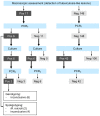Surveillance of bovine tuberculosis and risk estimation of a future reservoir formation in wildlife in Switzerland and Liechtenstein
- PMID: 23349839
- PMCID: PMC3549981
- DOI: 10.1371/journal.pone.0054253
Surveillance of bovine tuberculosis and risk estimation of a future reservoir formation in wildlife in Switzerland and Liechtenstein
Abstract
Bovine tuberculosis (bTB) caused by Mycobacterium bovis or M. caprae has recently (re-) emerged in livestock and wildlife in all countries bordering Switzerland (CH) and the Principality of Liechtenstein (FL). Comprehensive data for Swiss and Liechtenstein wildlife are not available so far, although two native species, wild boar (Sus scrofa) and red deer (Cervus elaphus elaphus), act as bTB reservoirs elsewhere in continental Europe. Our aims were (1) to assess the occurrence of bTB in these wild ungulates in CH/FL and to reinforce scanning surveillance in all wild mammals; (2) to evaluate the risk of a future bTB reservoir formation in wild boar and red deer in CH/FL. Tissue samples collected from 2009 to 2011 from 434 hunted red deer and wild boar and from eight diseased ungulates with tuberculosis-like lesions were tested by direct real-time PCR and culture to detect mycobacteria of the Mycobacterium tuberculosis complex (MTBC). Identification of suspicious colonies was attempted by real-time PCR, genotyping and spoligotyping. Information on risk factors for bTB maintenance within wildlife populations was retrieved from the literature and the situation regarding identified factors was assessed for our study areas. Mycobacteria of the MTBC were detected in six out of 165 wild boar (3.6%; 95% CI: 1.4-7.8) but none of the 269 red deer (0%; 0-1.4). M. microti was identified in two MTBC-positive wild boar, while species identification remained unsuccessful in four cases. Main risk factors for bTB maintenance worldwide, including different causes of aggregation often resulting from intensive wildlife management, are largely absent in CH and FL. In conclusion, M. bovis and M. caprae were not detected but we report for the first time MTBC mycobacteria in Swiss wild boar. Present conditions seem unfavorable for a reservoir emergence, nevertheless increasing population numbers of wild ungulates and offal consumption may represent a risk.
Conflict of interest statement
Figures






Similar articles
-
Factors that Influence Mycobacterium bovis Infection in Red Deer and Wild Boar in an Epidemiological Risk Area for Tuberculosis of Game Species in Portugal.Transbound Emerg Dis. 2017 Jun;64(3):793-804. doi: 10.1111/tbed.12439. Epub 2015 Oct 31. Transbound Emerg Dis. 2017. PMID: 26519121
-
Spoligotype diversity and 5-year trends of bovine tuberculosis in Extremadura, southern Spain.Trop Anim Health Prod. 2016 Dec;48(8):1533-1540. doi: 10.1007/s11250-016-1124-4. Epub 2016 Aug 14. Trop Anim Health Prod. 2016. PMID: 27524741
-
Implications and challenges of tuberculosis in wildlife ungulates in Portugal: a molecular epidemiology perspective.Res Vet Sci. 2012 Apr;92(2):225-35. doi: 10.1016/j.rvsc.2011.03.009. Epub 2011 Apr 2. Res Vet Sci. 2012. PMID: 21459394
-
Evaluating the tuberculosis hazard posed to cattle from wildlife across Europe.Res Vet Sci. 2014 Oct;97 Suppl:S86-93. doi: 10.1016/j.rvsc.2013.12.002. Epub 2013 Dec 15. Res Vet Sci. 2014. PMID: 24423727 Review.
-
Mycobacterium bovis: characteristics of wildlife reservoir hosts.Transbound Emerg Dis. 2013 Nov;60 Suppl 1:1-13. doi: 10.1111/tbed.12115. Transbound Emerg Dis. 2013. PMID: 24171844 Review.
Cited by
-
Investigating the role of free-ranging wild boar (Sus scrofa) in the re-emergence of enzootic pneumonia in domestic pig herds: a pathological, prevalence and risk-factor study.PLoS One. 2015 Mar 6;10(3):e0119060. doi: 10.1371/journal.pone.0119060. eCollection 2015. PLoS One. 2015. PMID: 25747151 Free PMC article.
-
Harmonizing methods for wildlife abundance estimation and pathogen detection in Europe-a questionnaire survey on three selected host-pathogen combinations.BMC Vet Res. 2017 Feb 16;13(1):53. doi: 10.1186/s12917-016-0935-x. BMC Vet Res. 2017. PMID: 28202055 Free PMC article.
-
Mycobacterium microti: Not Just a Coincidental Pathogen for Cats.Front Vet Sci. 2020 Dec 3;7:590037. doi: 10.3389/fvets.2020.590037. eCollection 2020. Front Vet Sci. 2020. PMID: 33344530 Free PMC article.
-
Causes of mortality and morbidity in free-ranging mustelids in Switzerland: necropsy data from over 50 years of general health surveillance.BMC Vet Res. 2018 Jun 19;14(1):195. doi: 10.1186/s12917-018-1494-0. BMC Vet Res. 2018. PMID: 29921290 Free PMC article.
-
Mycobacterium microti Infection in Red Foxes in France.Microorganisms. 2021 Jun 9;9(6):1257. doi: 10.3390/microorganisms9061257. Microorganisms. 2021. PMID: 34207760 Free PMC article.
References
-
- Aranaz A, Cousins D, Mateos A, Dominguez L (2003) Elevation of Mycobacterium tuberculosis subsp. caprae Aranaz et al. 1999 to species rank as Mycobacterium caprae comb. nov., sp. nov. Int J Syst Evol Microbiol 53: 1785–1789. - PubMed
-
- Bouakaze C, Keyser C, Gonzalez A, Sougakoff W, Veziris N, et al. (2011) Matrix-assisted laser desorption ionization-time of flight mass spectrometry-based single nucleotide polymorphism genotyping assay using iPLEX gold technology for identification of Mycobacterium tuberculosis complex species and lineages. J Clin Microbiol 49: 3292–3299. - PMC - PubMed
-
- Cousins DV, Bastida R, Cataldi A, Quse V, Redrobe S, et al. (2003) Tuberculosis in seals caused by a novel member of the Mycobacterium tuberculosis complex: Mycobacterium pinnipedii sp nov. Int J Syst Evol Microbiol 53: 1305–1314. - PubMed
-
- Amanfu W (2006) The situation of tuberculosis and tuberculosis control in animals of economic interest. Tuberculosis (Edinb) 86: 330–335. - PubMed
Publication types
MeSH terms
Substances
LinkOut - more resources
Full Text Sources
Other Literature Sources

